B2B content marketing is a bit like selling toys to a kid. Your first job is to get the kid excited, using flashy adverts to show them all the fun they can have, and the different ways they can use the toy.
But kids have no money, so you also need to persuade their parents to open their wallets. Parents care less about fun, and more about boring things like pricing, safety, and durability. Adverts alone won’t work: you need guarantees and safety manuals too.
To make the sale, you need to persuade on two fronts—but take too long, and the kid will forget all about you and buy something else instead.
Here are the types of content we create for our B2B content marketing strategy, here at Ahrefs:
Blog articles
At Ahrefs, SEO content (like the blog post you’re reading) forms the backbone of our B2B marketing efforts. These are long-form written articles, targeted at specific business-relevant keywords, and written to help the searcher and match their search intent:

If that sounds complicated, don’t worry. Read our full guide to creating amazing SEO content: SEO Content: The Beginner’s Guide.
We also create a lot of thought leadership content, like opinion pieces, essays, and original research:
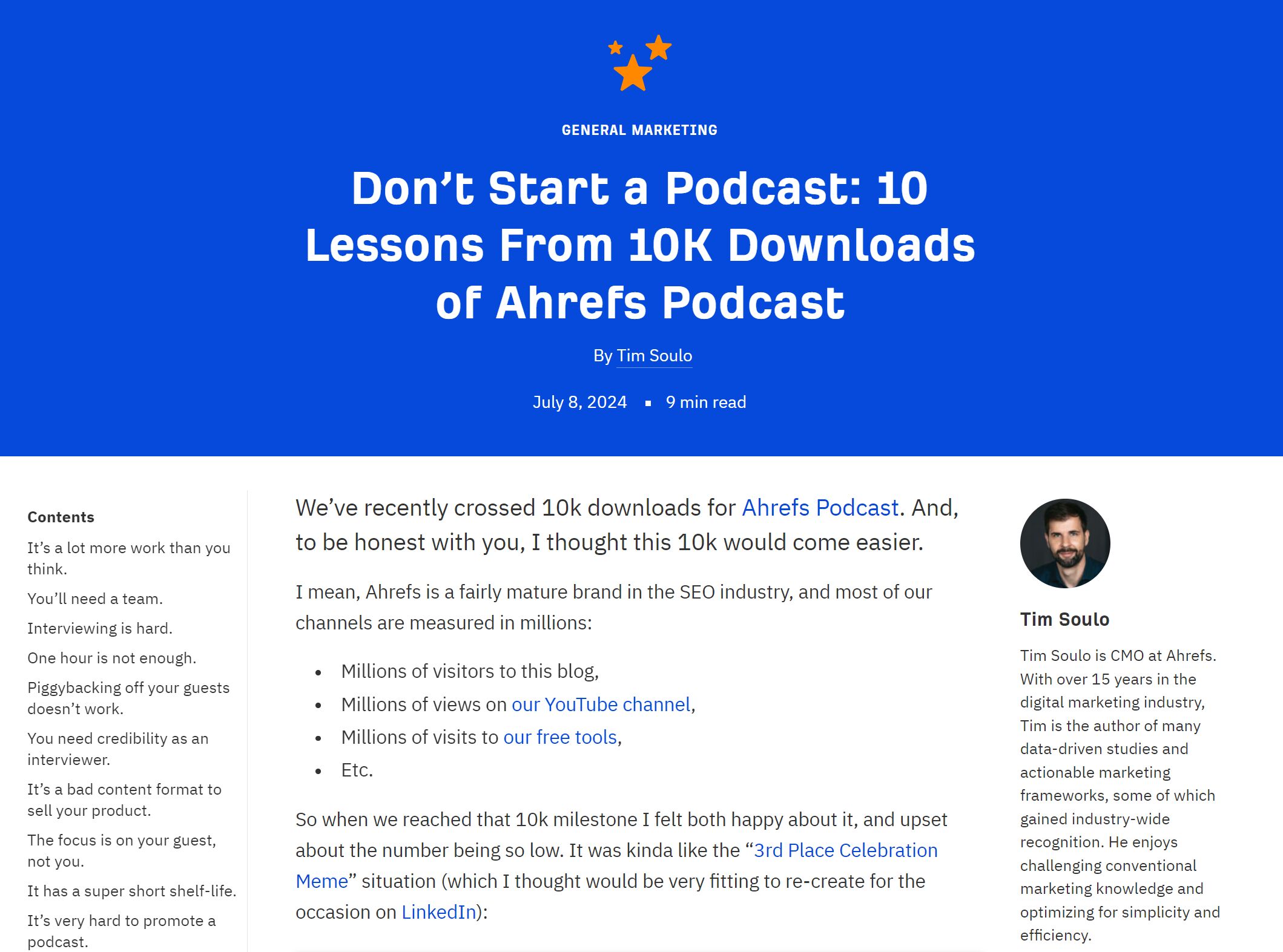
These articles don’t target keywords, but they do help us communicate important messages to potential customers, generate discussion and debate on social media, and land much-sought-after backlinks.
Educational videos
Our YouTube channel is another crucial part of our marketing strategy. Our video team create a mixture of educational content, entertaining (we hope) experiments and stunts, and product updates:
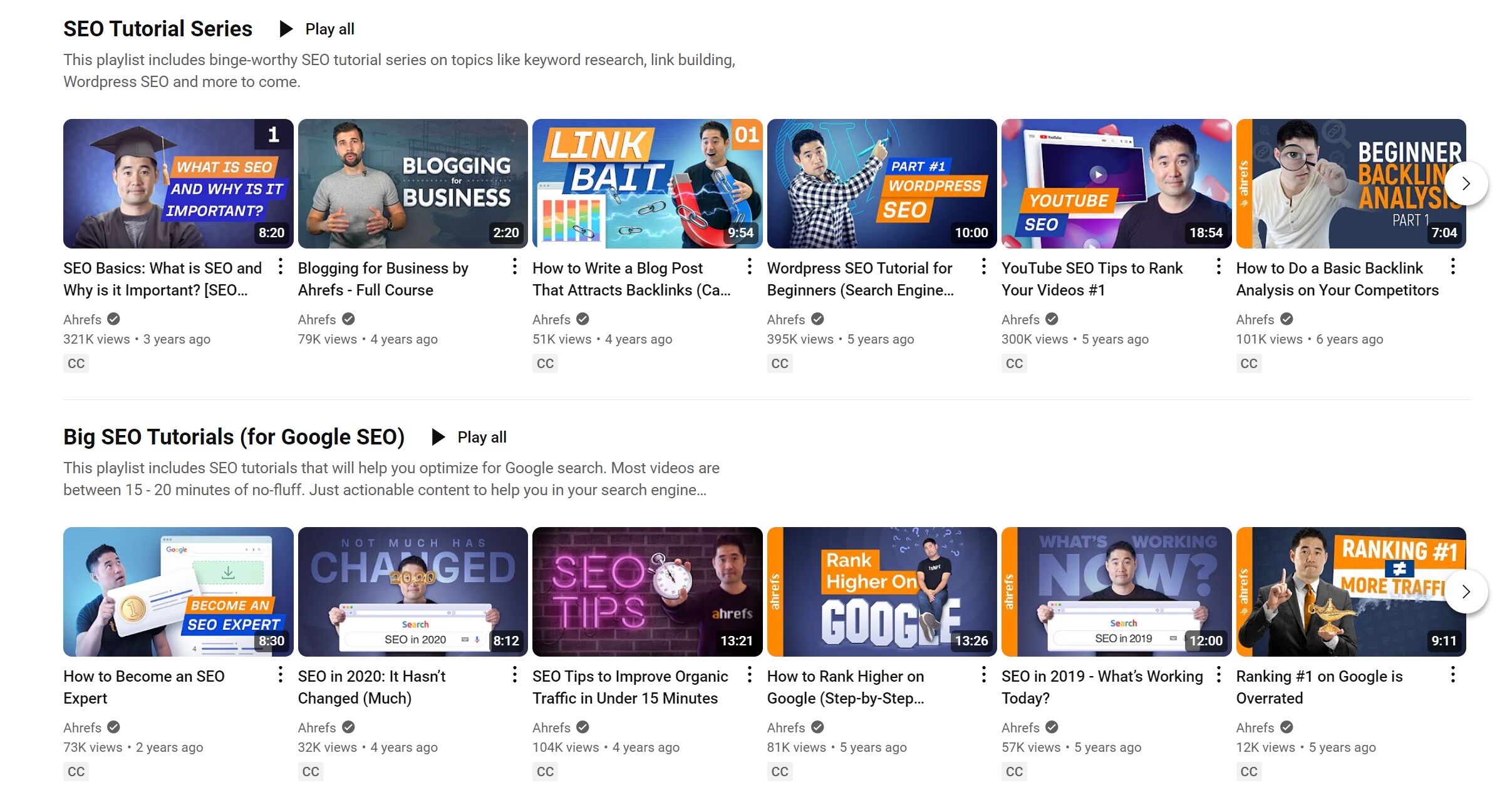
Industry reports
We also create regular industry reports: surveys or data analysis that help answer important questions in our industry, like “How long does it take to rank in Google?” or “How many keywords can you rank for with one page?”:

These studies are great for generating backlinks, and they provide tons of data and statistics to include in all our other content.
Some companies also offer these research reports as downloadable PDFs, as a way to generate emails for their sales team to nurture.
Podcasts
Podcasts are popular because they’re so easy to create: just get onto a Zoom call with someone smart, ask a bunch of questions, and publish the conversation.
But increasingly, companies are investing more and more effort into making their podcasts stand out, like the hours of research our CMO Tim puts into the Ahrefs podcast:
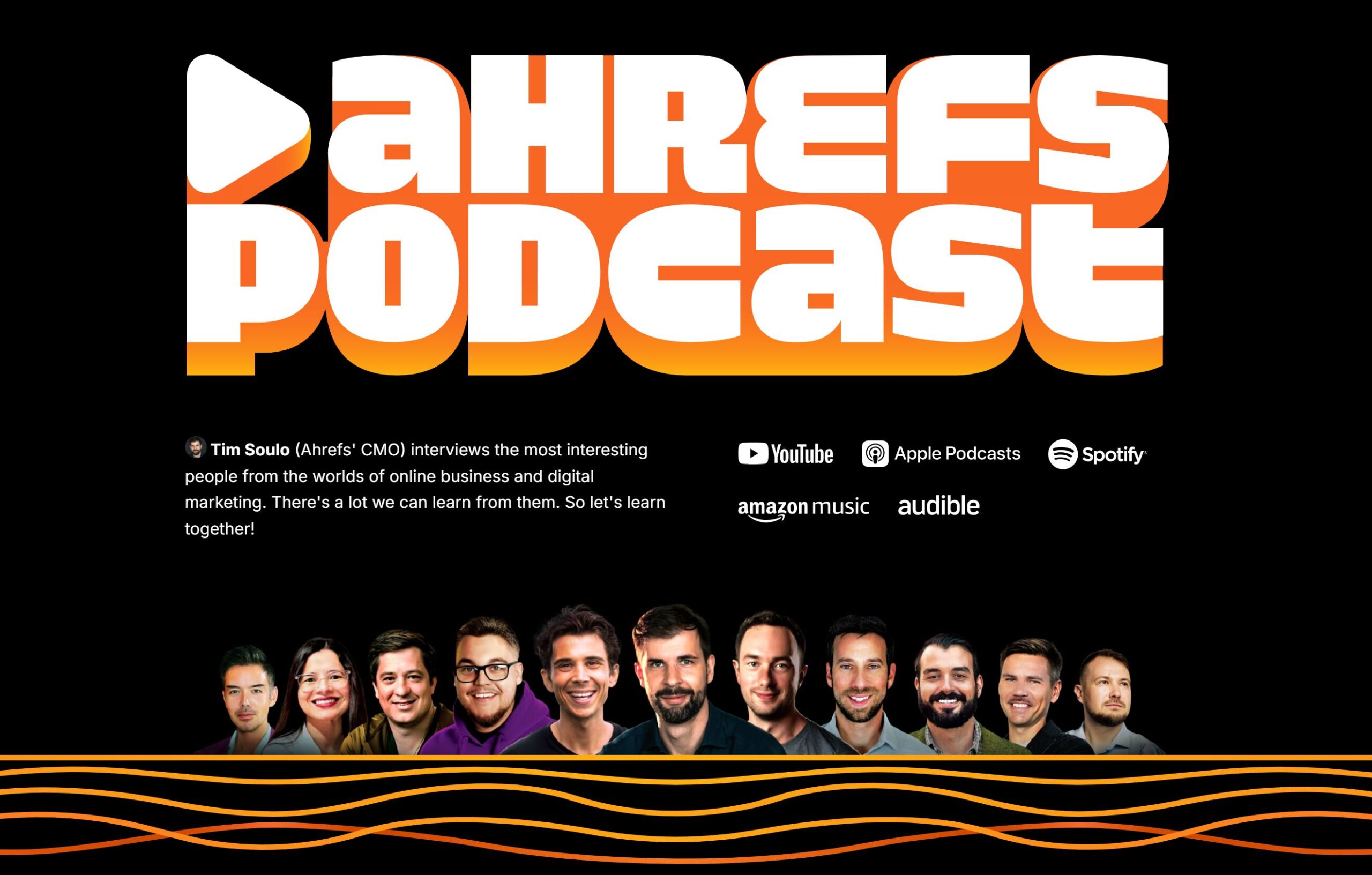
There’s also a blurred line between podcasts and video content, as it’s become very easy to post video versions of podcasts on YouTube and social media, like we do:
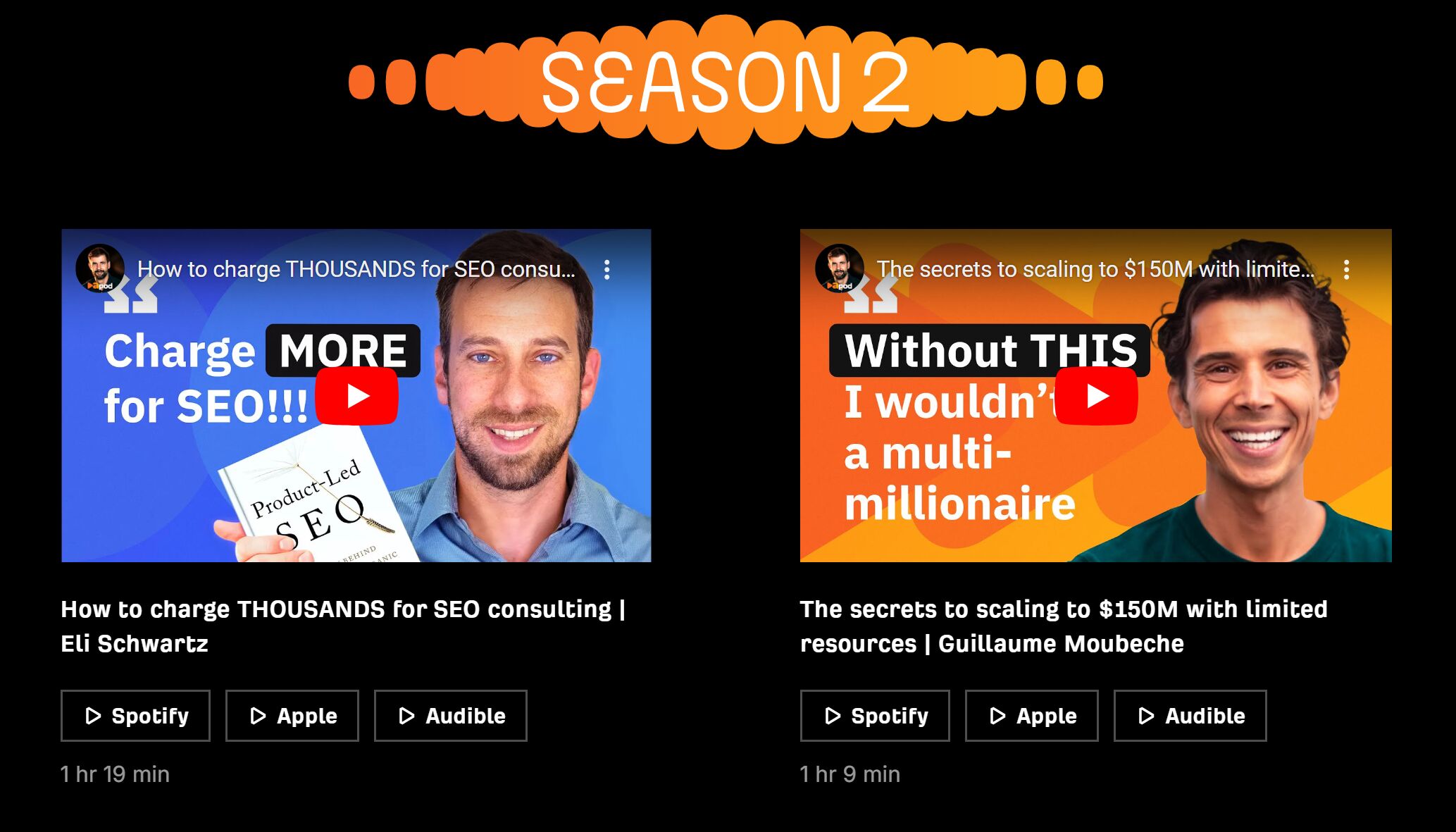
Infographics
At Ahrefs, we usually create infographics—visual representations of key ideas and data—to help promote our blog posts on social media:
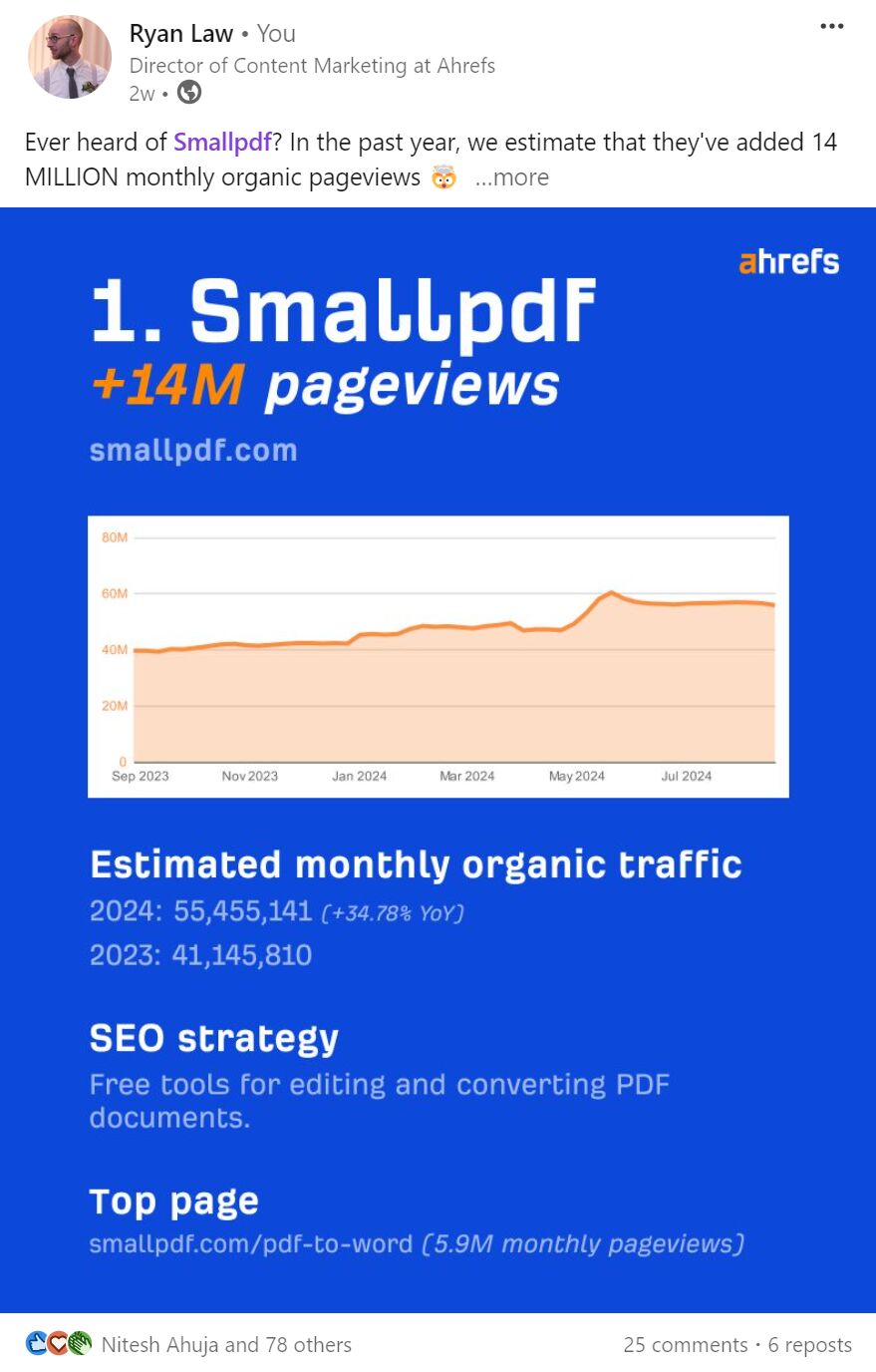
Case studies
Case studies are short, persuasive documents that highlight the benefits companies have earned from buying your product:
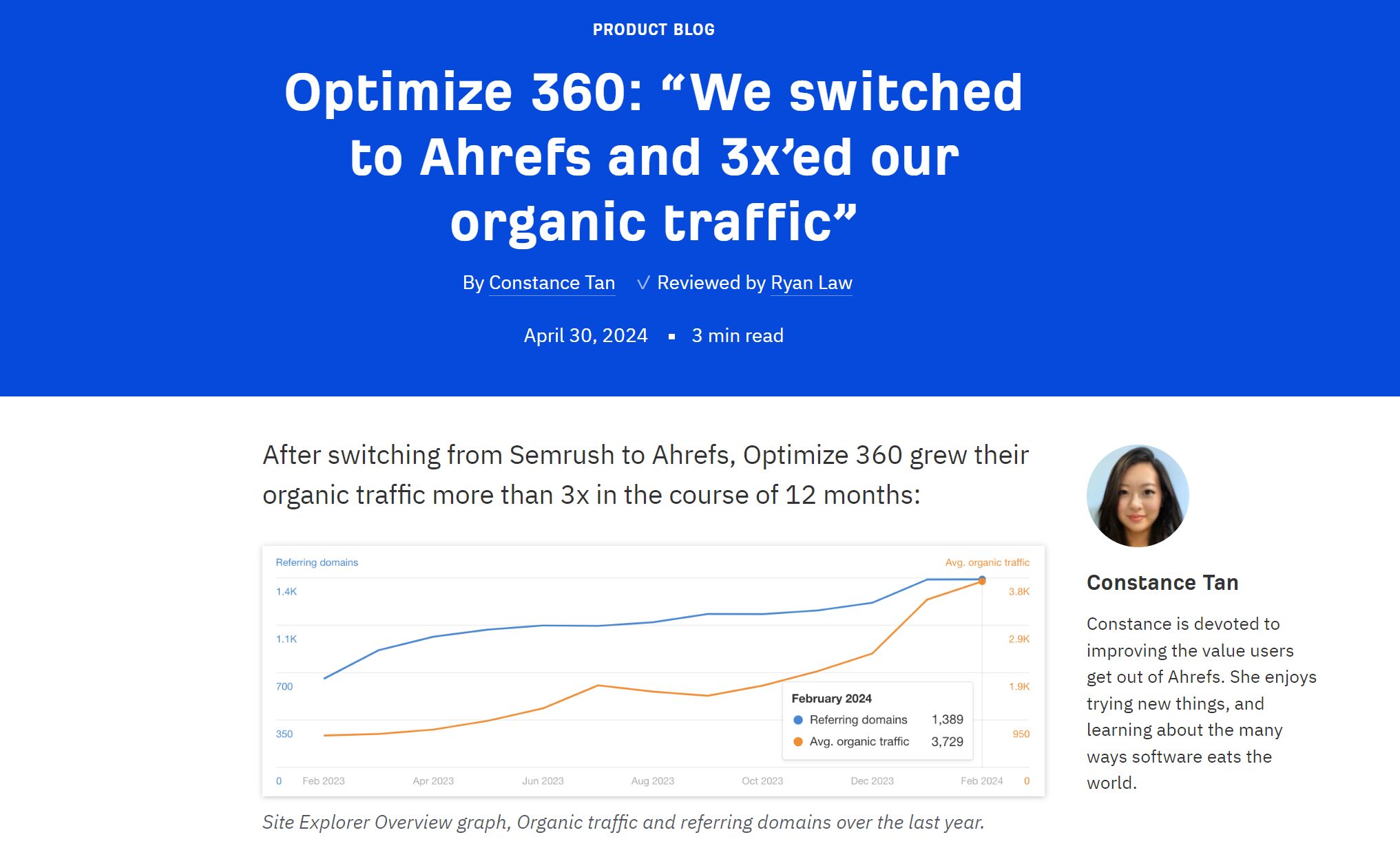
Case studies also act as powerful social proof (“If our competitors bought this, we should too!”).
Courses & webinars
We also turn many of our blog articles and research reports into educational courses and webinars: interactive, online presentations that offer a different way to engage with information:
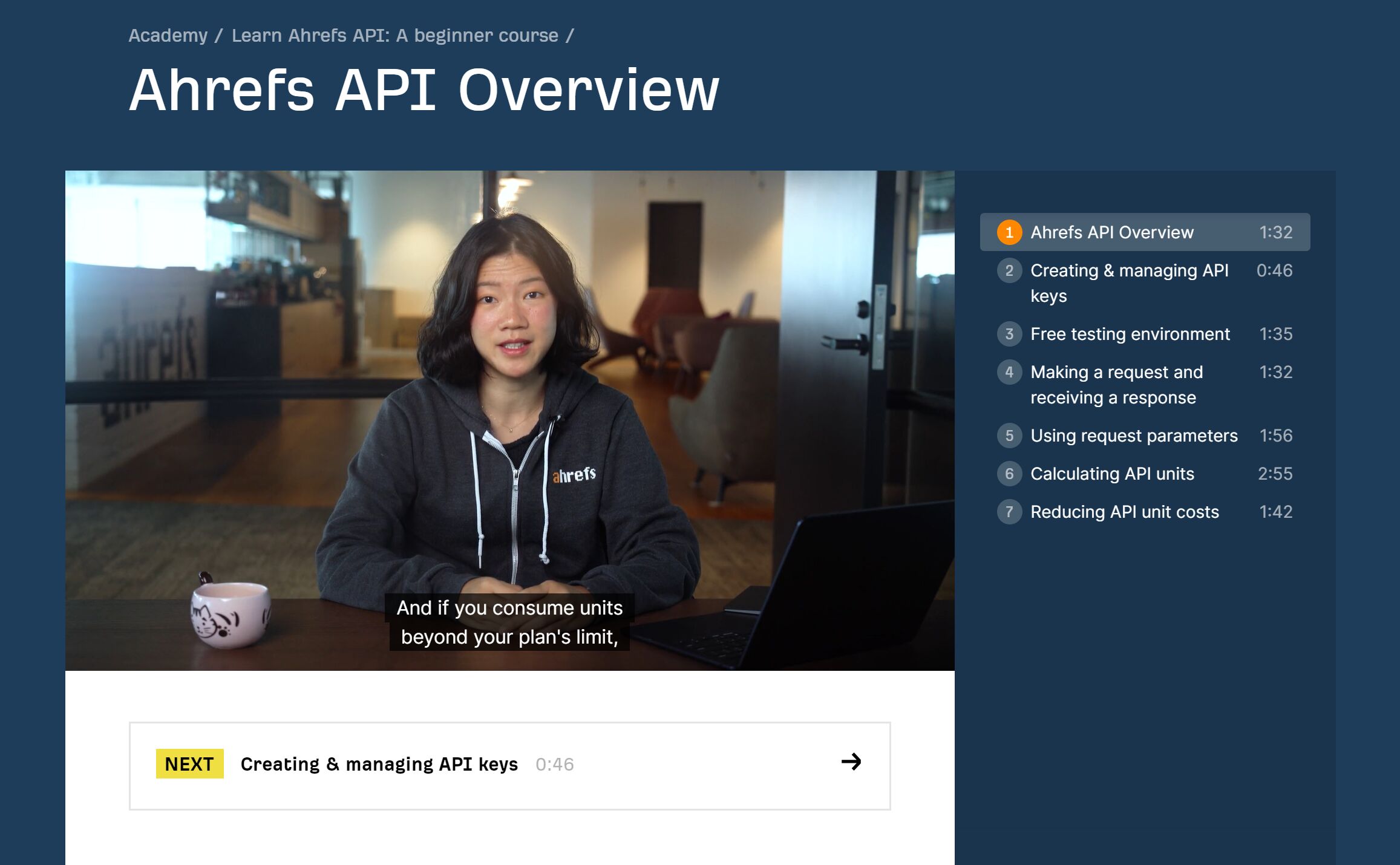
Many of the core rules of content marketing still apply, but in B2B, there are extra challenges your content will need to solve. (We’ll explain exactly how in the next section.)
1. Multiple people involved in every purchase
This is the core difference between regular content marketing and B2B content marketing. In regular content marketing, you need to persuade just one person: get them excited enough and they’ll open their wallet and purchase.
Selling to businesses is different. Most purchases require input and approval from multiple people:
- The people who use your product aren’t always the same people who will buy it. Maybe graphic designers use your product, but their CMO is the one with the budget.
- Different departments and decision-makers are involved in the purchase. If your product or service will get used by the design team, and the content team, and the website team, you’ll need everyone to come to an agreement on the purchase.
- You might need to work with procurement, legal, and compliance teams. Depending on what you’re selling, you might need to persuade a bunch of different “blockers” that you’re low risk, or good value, or compliant with any relevant legislation. (Fun!)
Each of the people involved care about different things, and each has the potential to stop the sale dead in its tracks. Your content will need to appeal to and persuade all of them.
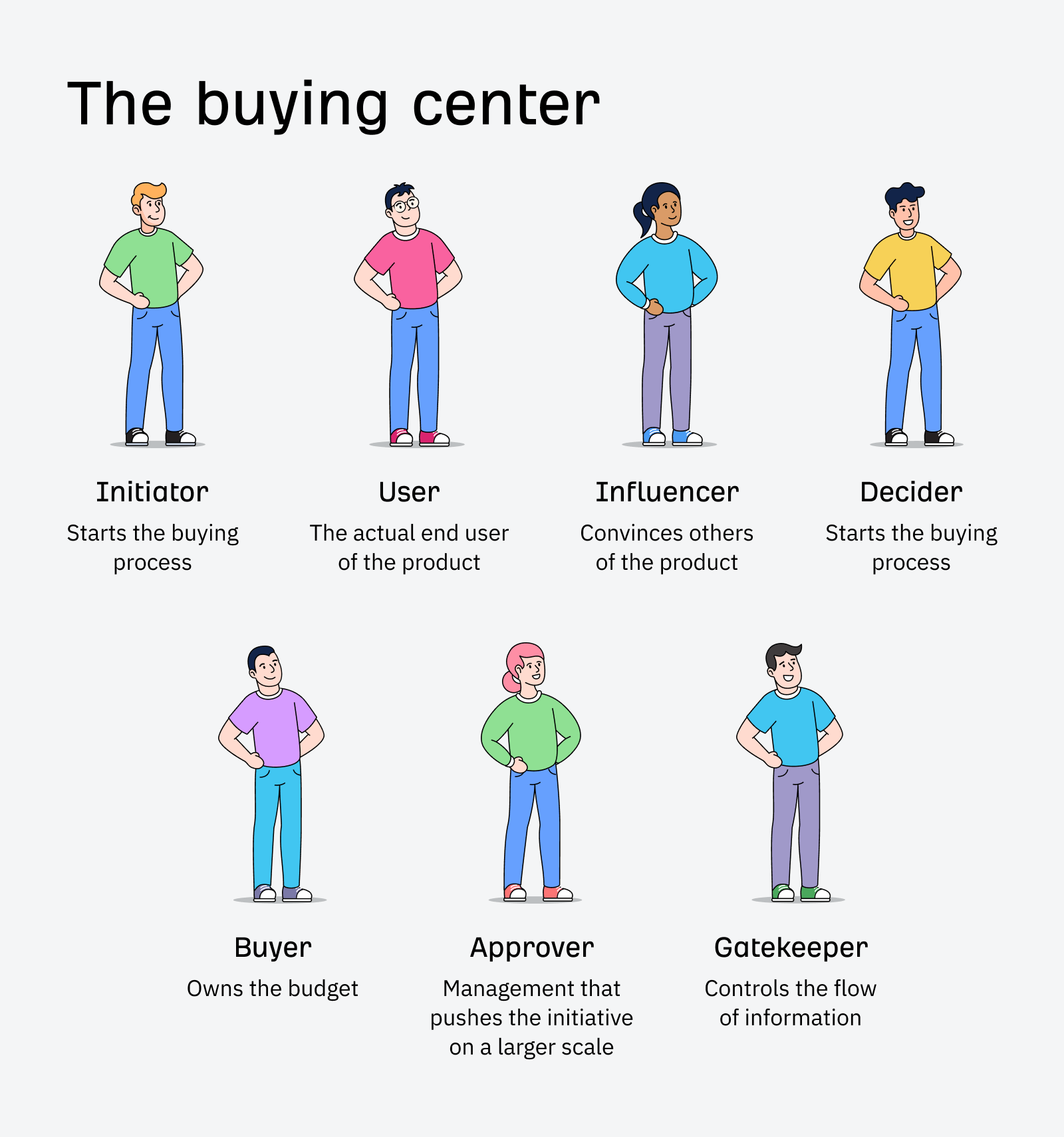
2. Big deal sizes mean increased scrutiny
One of the perks of selling to a big business: you can charge lots of money. But that brings a downside, in the form of increased scrutiny. You’ll need to persuade would-be customers that your product works; that you have a track record of solving problems for similar companies; even that you’re better value than building something similar in-house.
3. Long, drawn-out sales cycles
Expensive purchases and involvement from tons of different people all cause the same problem: sales processes that take months, or even years, to finally close.
This adds extra complexity. You need to stay front-of-mind, keeping everyone involved in the purchase excited and engaged for months on end. You need to ensure good information hand-off between everyone involved—including when people leave the company or move into new roles.
4. Complicated products
Many businesses rely on free trials to persuade potential customers: they can check out the app, for free, and easily upgrade if they think it’s valuable.
But many B2B products are too complex for this tactic (imagine having a free trial of a workspace management platform, designed to integrate with dozens of apps). In these cases, your content needs to step into the breach, showing all the different ways your product or service can be used and bring value to customers.
5. Small target market
Some B2B products are extremely niche, and the total audience of people that can buy them may be as small as a few thousand, or even a few hundred. These buyers can be difficult to reach through conventional content channels too (how many post-IPO SaaS CFOs are there in the world, and how many routinely Google “saas metrics”?). You may need to get creative with distribution.
I interviewed experienced B2B content marketers to find out exactly how they solve these problems through their content. I talked to:
- Eliana Cameira, Content Marketing Manager at Persefoni, a carbon accounting platform
- Mark Rogers, Director of Content Marketing at Freshpaint, a healthcare marketing compliance tool
- Joe Michaloswki, Director of Content at Mosaic.tech, a financial analytics platform
Start by mapping out all the different people involved in your buying process, and the role they play. Are they the end user, someone that needs to be excited about the features and functionality? Or are they a blocker, someone who can derail the sale if your product feels too expensive or risky?
For Mark and Freshpaint, every sale has the potential to involve half a dozen people, with very different motivations:
| Persona | Role | Pain points |
|---|---|---|
| Healthcare marketers | User | Want to use analytics and retargeting in their marketing |
| Marketing lead | Buyer | Need to make their marketing analytics HIPPA compliant as soon as possible, without spending too much |
| Legal teams | Blocker | Worried about being sued for non-compliant marketing |
| Compliance teams | Blocker | Need to ensure the product is thoroughly compliant |
| IT teams | Blocker | Would prefer to build the solution themselves |
The point of content marketing is to make sales easier. In B2B content marketing, that means creating content for each of the people involved in the sales process, solving their problems, or addressing their concerns.
This is where the idea of the marketing funnel can be helpful.
Top of the funnel content
Top of the funnel (ToFu) content is designed to attract the attention of people who might want to buy your product: usually end-users. ToFu content can include:
- Solving their problems, like helping healthcare marketers understand which web trackers do—and don’t—jeopardize HIPAA compliance.
- Explaining useful concepts, like helping startup finance teams brush up on their knowledge of arcane financial metrics, like committed ARR or burn multiples.
- Sharing opinions about their industry, like helping sustainability executives understand why non-compliance with the SEC’s climate disclosure rule is not a good idea.
Middle of the funnel content
Middle of the funnel (MoFu) content helps your company stay front-of-mind with those people, even if they’re not quite ready to purchase, and introduces your product in measured, helpful ways. MoFu content might entail:
- Hosting events and webinars, like Mosiac’s webinar exploring the different tools in the modern finance tech stack.
- Sharing motivating use cases, like explaining how Freshpaint can be used to embed YouTube videos on your website in a HIPPA-compliant way.
Bottom of the funnel content
Bottom of funnel (BoFu) content is designed to persuade decision-makers and reassure potential blockers. It provides documented answers to the biggest questions that might derail a sale (Is this good value? Does it work? Does this company have a good track record?), in the form of:
- Publishing case studies, like Mosaic explaining how they helped one customer save $1.2MM.
- Writing detailed FAQS, like Freshpaint exploring the minutiae of how their product integrates with GA4.
- Creating competitor comparison pages, like Persefoni showing how they stack up with similar platforms.
If funnel stages are confusing (they are to me), the key point is simple: create content to motivate or persuade every person involved in the sales process.
To get your content in front of the right people, at the right time, use the three S’s: search, social, and sales.
Search optimization
Search optimization is crucial for B2B content marketing, for one simple reason: a single search-optimized article can lead to more and more traffic each month.
Many of Mosaic.tech’s customers discover the company through its glossary of financial metrics and terms. The glossary ranks for over 20,000 keywords and generates an estimated 43,000 monthly organic pageviews.
Basic metrics (like annual contract value) help put the company on the radar of thousands of junior and aspiring finance pros; advanced metrics (like burn multiple or remaining performance obligations) often attract the attention of their SaaS CFOs themselves.
“The glossary is a strong driver of pipeline for us. And you just wouldn’t expect that. It’s like, hey, I sold a $30,000 software product by telling a VP of Finance the definition of a metric that they absolutely know already. But it works.”
Ahrefs makes it easy to brainstorm relevant keywords in your own industry. Just head to Keywords Explorer and use one of AI presets to magically create a list of seed keywords related to your industry.
Here, I asked for “technical and specialized terms” relating to financial metrics. A few seconds later, we have two dozen seed keywords. Click “Search” and we can see how much search volume these keywords have:

Social media
Social media is useful for reaching personas that are harder to find through search alone. Persefoni use LinkedIn to connect with their target buyers, and share their thought leadership and expert perspectives.
“For our buyers, LinkedIn is the primary social platform. Some of our industry experts at Persephone have networks of 20k plus people. We get them to share our content through their networks and trigger a multiplying effect.”
Sales teams
If the goal of B2B content marketing is to make sales easier, don’t overlook the most obvious distribution channel: sharing content with your sales team. Most of the content created by Mark at Freshpaint is given to the sales team to share directly with potential customers or use as follow-up material afterward.
“I spent a lot of time talking to the sales team, figuring out what was missing in their arsenal. If I’m helping them close more business, then I’m doing my job.”
It can take months (or even years) for a new visitor to be ready and willing to make a purchase. To stay front of mind, B2B companies use gated content to turn anonymous visitors into contactable leads: offering access to books, whitepapers, or events in exchange for an email address.
Eliana and the Persefoni team created the Persefoni Academy, a series of free educational courses about carbon accounting and decarbonization. Joe at Mosaic.tech published a library of 17 ebooks, ranging from a SaaS metrics cheatsheet to a financial planning blueprint.
Joe thinks about ebooks as part of the bigger content strategy: a persona’s pain point is explored in an ebook, which is then repurposed into search-targeted blog posts, each with the ebook offered as gated content:
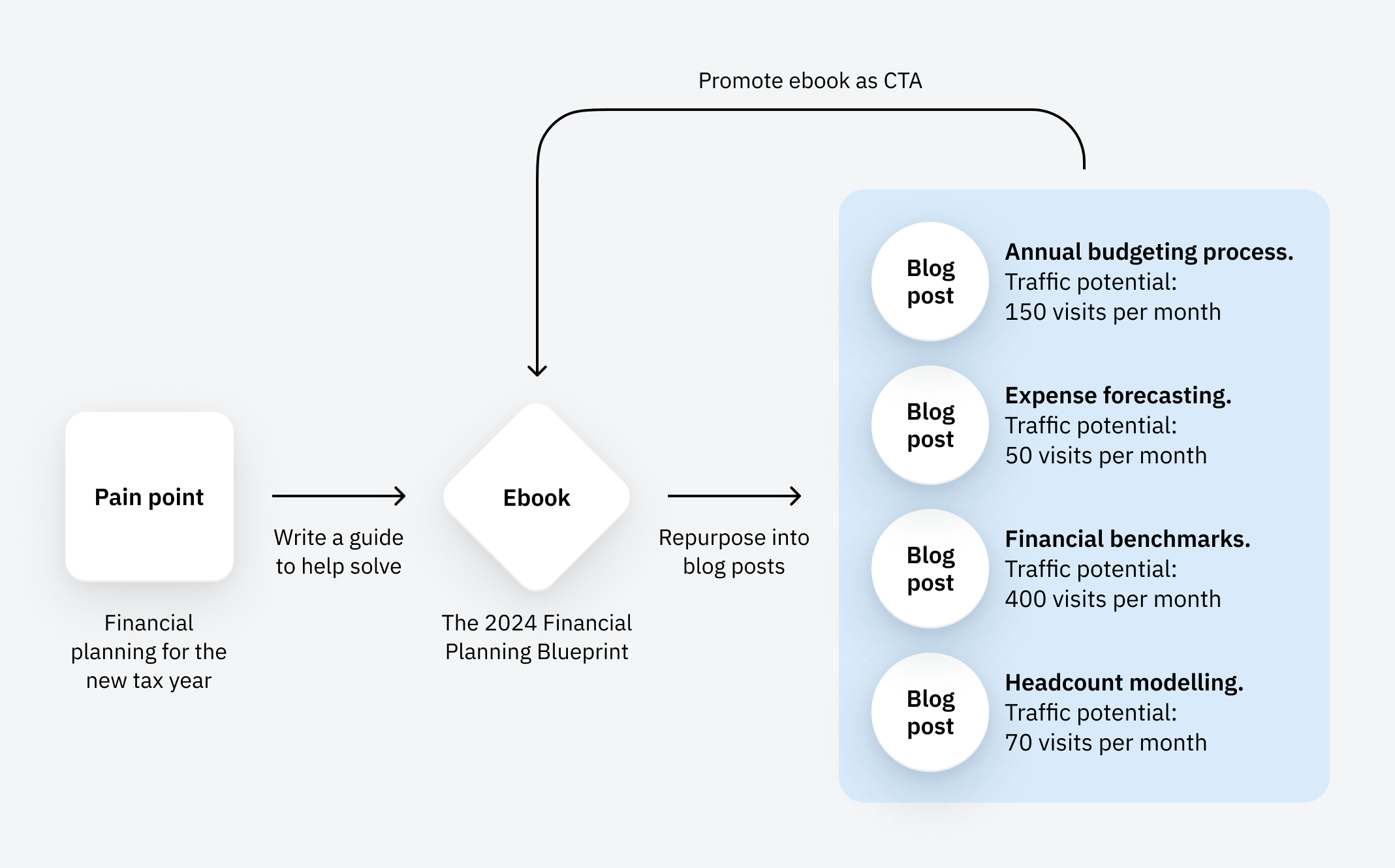
With an email address, you can keep in touch with leads: sending a regular newsletter, promoting your latest content; offering an email course, designed to teach a useful concept; or just sharing regular product updates.
There are also ways to stay front of mind without relying on email. Persefoni, Freshpaint, and Mosaic.tech all use retargeting: showing adverts to visitors once they’ve left the website. Eliana at Persefoni is also a big fan of content repurposing: taking an article, content download, or webinar, and sharing snippets from it across all the other channels a visitor might use:
“What surprised me the most is the number of touch points required to influence a successful sales opportunity. It was—spoiler alert—much more than I was imagining. It required more than just one content download, or one webinar registration: it was multiple touchpoints, across multiple channels, which really reinforced the importance of us having a sound holistic distribution strategy.”
Finally: track your performance to do more of what works (and less of what doesn’t). Across the companies we talked to, content marketing KPIs commonly fell into a handful of core categories:
- Website traffic (more traffic generally means more potential customers)
- Lead volume (the number of leads generated in a given period)
- Lead quality (leads become “sales-qualified” if the sales team believe a sale is possible)
- Weekly touchpoints (how frequently a lead is interacted with)
- Demo requests (more demos should mean more customers)
Final thoughts
B2B content marketing can sound complicated, but the core difference is a simple one: there are multiple people that can make (or break) a sale. Your content marketing needs to attract and persuade multiple people, each with different motivations and interests, and keep them interested over long periods of time.
It isn’t always easy, but the payoff is worthwhile: many B2B deals can run to hundreds of thousands (even millions) of dollars.






